 |
|
|
|

Days Three, Four, and Five of our Voyage of Discovery were dedicated to collecting the data the students would need to test their hypotheses. Most students collected their data while the Half Moon was at layover at Niantic Bay, CT, but measuring current speed and the height of tide, as well as tracking the moon, took place at our safe port at East Haddam as well.
|
Presentation Project Topics |
|
|
|
|
During the data collection phase, each student research team established a work schedule for gathering data, collected and analyzed samples, and recorded their findings.
You can scroll down or use the links to jump directly to a section.
|
Research Team 1: Celestial Tracking
|
| 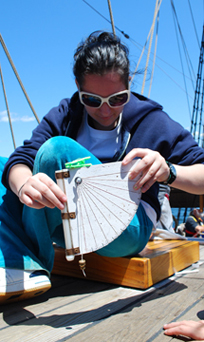 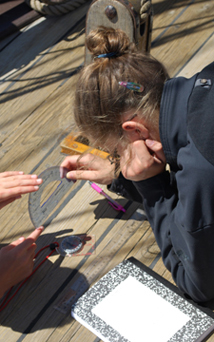 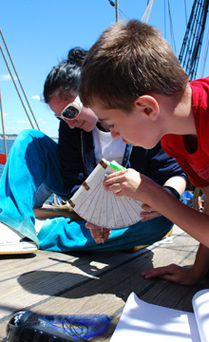
Students: Elaina, Loren, & Michael
Senior Crew Advisor: Mary Ellen Jacobs
Materials: Quadrant, directional compass.
Elaina, Loren, and Michael are conducting two different celestial tracking experiments. In Niantic Bay, Elaina, Loren, and Michael are using a quadrant to determine the altitude of the Sun and a directional compass to mark its bearing. To do so, they use their instruments' shadows to properly align them, rather than looking directly at the Sun. Through the morning and into the afternoon, they take regular readings to determine the Sun's apex and azimuth, from which they can derive true noon and true south.
Secondly, the research team is utilizing data collected by Anchor Watch for the Deck Log to track the progress of the Moon over the course of four nights, seeking to determine whether its patterns hold steady or whether they vary over time.
|
Back to Top
|
Research Team 2: Mechanical Advantage
|
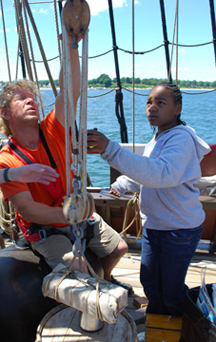 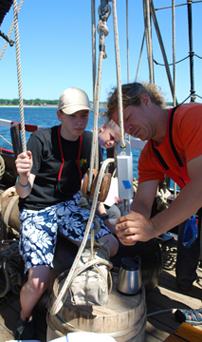 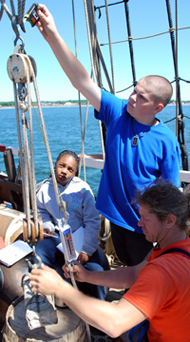
Students: Tajanae, Alex, & Jon
Senior Crew Advisor: Ewout van Grondelle
Materials: Spring scale, lead ballast ingot, block & tackle simple machine.
With the assistance of Mr. Van Grondelle, Alex, Jon, and Tajanae test the properties of mechanical advantage by constructing an adjustable block-and tackle simple machine on the weather deck. They then rig different combinations of pulleys and leads to see how these affect the force needed to lift a 60-pound lead ballast ingot up a distance of 15 cm. With each configuration, they record the force needed to lift the ingot (as measured on the spring scale) and the distance they need to pull the line to hoist the weight to the same height.
|
|
Research Team 3: Comparative Temperatures
|
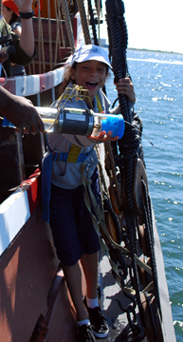 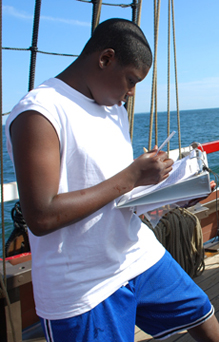 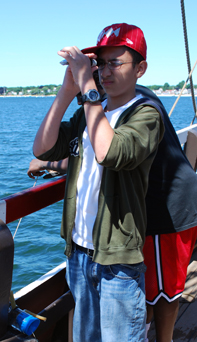
Students: Alanna, Tyron, & Jose
Senior Crew Advisor: Deb Cowles
Materials: Digital thermometer, wet thermometer, canvas bucket, Van Dorn sampler.
Starting during our data collection layover in Niantic Bay and continuing through our layover at East Haddam, Alanna, Jose, and Tyron are using thermometers and a canvas bucket to measure the temperature of the air and surface water, and the Van Dorn sampler to test the temperature of water at various depths. In addition, they are utilizing data collected by the crew on Anchor Watch to continue tracking air and surface water temperatures through a full 24-hour cycle.
|
Back to Top
|
Research Team 4: Current Patterns & Depth of Tide |
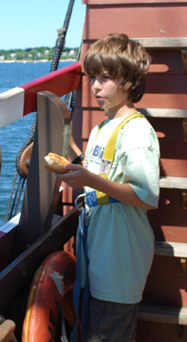 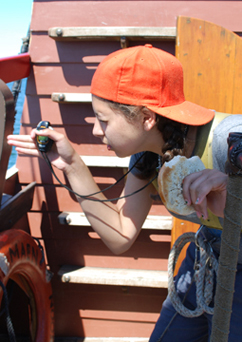
Students: DeNiro, Matt, & Nadia
Senior Crew Advisor: Captain Reynolds
Materials: Lead line, wooden biscuits, stopwatch, calculator, stale bagels, hand held anemometer.
During our data layover in Niantic Bay, DeNiro, Matt, and Nadia will use a lead line to sound the bay's depth and the rest of their materials to measure the speed and direction of the current. (The stale bagels replace the wooden biscuits we typically use, based on the students' belief that they will biodegrade far more rapidly.)
They continue their research during our second layover at East Haddam, where a marked pole standing in for the lead line is lashed to the dock. This allows the Anchor Watch crew to safely measure changes in tide over the course of 24 hours; the team will incorporate this Deck Log data into their findings. They will also rely on the Deck Log to measure wind speed and direction.
|
|
|
|
|
|













